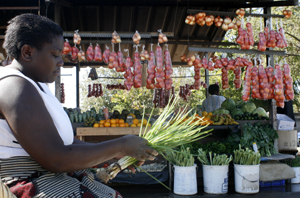ZIMBABWE: Sewage-fed vegetables give pause for thought
Maria Saungweme, 42, an informal trader and single mother from the low-income suburb of Glen Norah in the Zimbabwean capital Harare, uses sewage-infested river water to irrigate her two-acre vegetable plot.

Vegetables irrigated with sewage effluent carry health risks
“I am not proud to say this, but I consider the sewage that is offloaded into the river a blessing because it makes my vegetables grow well and fast. I have been selling my vegetables to other vendors for years and am earning enough to take care of my children,” Saungweme told IRIN.
She said she had not received complaints from her customers, but admitted her family did not consume her produce, preferring instead to buy from other vendors.
Scientific research has found that consuming vegetables irrigated with sewage effluent carries health risks. A 2009 study by Jos University in Nigeria, published in the Annals of African Medicine, found that "people consuming vegetables irrigated with raw waste water are exposed to the risk of infection with ascaris, amoeba and tapeworm."
But Saungweme insisted that she was not the only vendor selling vegetables irrigated with the river water. “A big amount of the vegetables that you see being sold in most of the suburbs are fertilized by sewage flowing into the rivers,” she said.
At an informal settlement about 2km from Saungweme’s vegetable plot, about 10 families depend on the contaminated river for drinking, cooking, bathing and washing.
“What’s wrong with the water? My eyes tell me it’s clean and we have been using it since we started staying here in 2005. Of course, now and then some of the squatters from here die, but I don’t see why their deaths should be blamed on the water,” a teenage resident of the settlement who identified himself as Jeff told IRIN.
The inability to upgrade sewage systems in Harare and Chitungwiza, a dormitory town about 35km southeast of the capital, has resulted in the two municipalities discharging raw human waste into tributaries of the River Manyame which feeds Lake Chivero, the main source of water for Harare and Chitungwiza residents, Harare Municipality town clerk Tendai Mahachi told parliament recently.
Because of the poor reticulation system and inadequate chemicals, the municipality was able to treat only 54 of the 144 megalitres of raw sewage produced daily, meaning that most of the water went untreated, he said.
Harare’s sewage system “was meant for a population that is much less than the current one”, he told parliament. The capital is officially estimated to have a population of 1.5 million people, but independent estimates indicate the figure could be as high as three million.
In a recent report, Harare mayor Muchadeyi Masunda said 60 percent of the capital’s residents did not have access to clean water, and 10 percent relied on boreholes and unprotected wells.
Waterborne diseases
Between January and March this year, Harare was hit by a typhoid outbreak -widely attributed to acute water shortages and poor sanitary conditions and practices - with more than 3,000 people seeking treatment and Health Ministry officials reporting two deaths.
The effects of Zimbabwe’s economic malaise since 2000, which has seen hyperinflation and a rapid decline in social services, left a legacy where “nothing was working”, Mahachi said.
Since an outbreak of cholera in 2008 claimed more than 4,000 lives, the UN Children’s agency (UNICEF) in Zimbabwe and international donors have been helping municipalities purify water by supplying water sanitizing/chlorinating chemicals, refurbishing water reticulation infrastructure and sinking boreholes.
Peter Salama, UNICEF country representative, told IRIN that the interventions were scheduled to end in June 2011, but that after an appeal from local authorities, they were extended until the end of March 2012. UNICEF is now phasing out the delivery of water treatment chemicals based on assurances from municipal officials that they could now supply their own.
However, doubts still linger whether local councils can go it alone; the government is yet to release a US$50 million grant it approved in February for the rehabilitation of water infrastructure and treatment.
Salama said boreholes sunk during the 2008 cholera outbreak to ease water shortages were breaking down or running dry and needed to be repaired.
“It is, however, not desirable to have boreholes as a long-term solution to water problems; rather piped water is the way to go,” he said, adding that his agency remained committed to promoting access to safe water despite phasing out purification interventions.
William Nduku of the Forum for Environmental Education, a local NGO, told IRIN sewage was not the only pollutant: “Contamination of water meant for human consumption… is not limited to the introduction of raw sewage into rivers but includes refuse dumping and industrial pollution that pose health risks and threaten biodiversity,” he said.
Source: IRIN
- 452 reads
Human Rights
Fostering a More Humane World: The 28th Eurasian Economic Summi

Conscience, Hope, and Action: Keys to Global Peace and Sustainability

Ringing FOWPAL’s Peace Bell for the World:Nobel Peace Prize Laureates’ Visions and Actions

Protecting the World’s Cultural Diversity for a Sustainable Future

Puppet Show I International Friendship Day 2020

